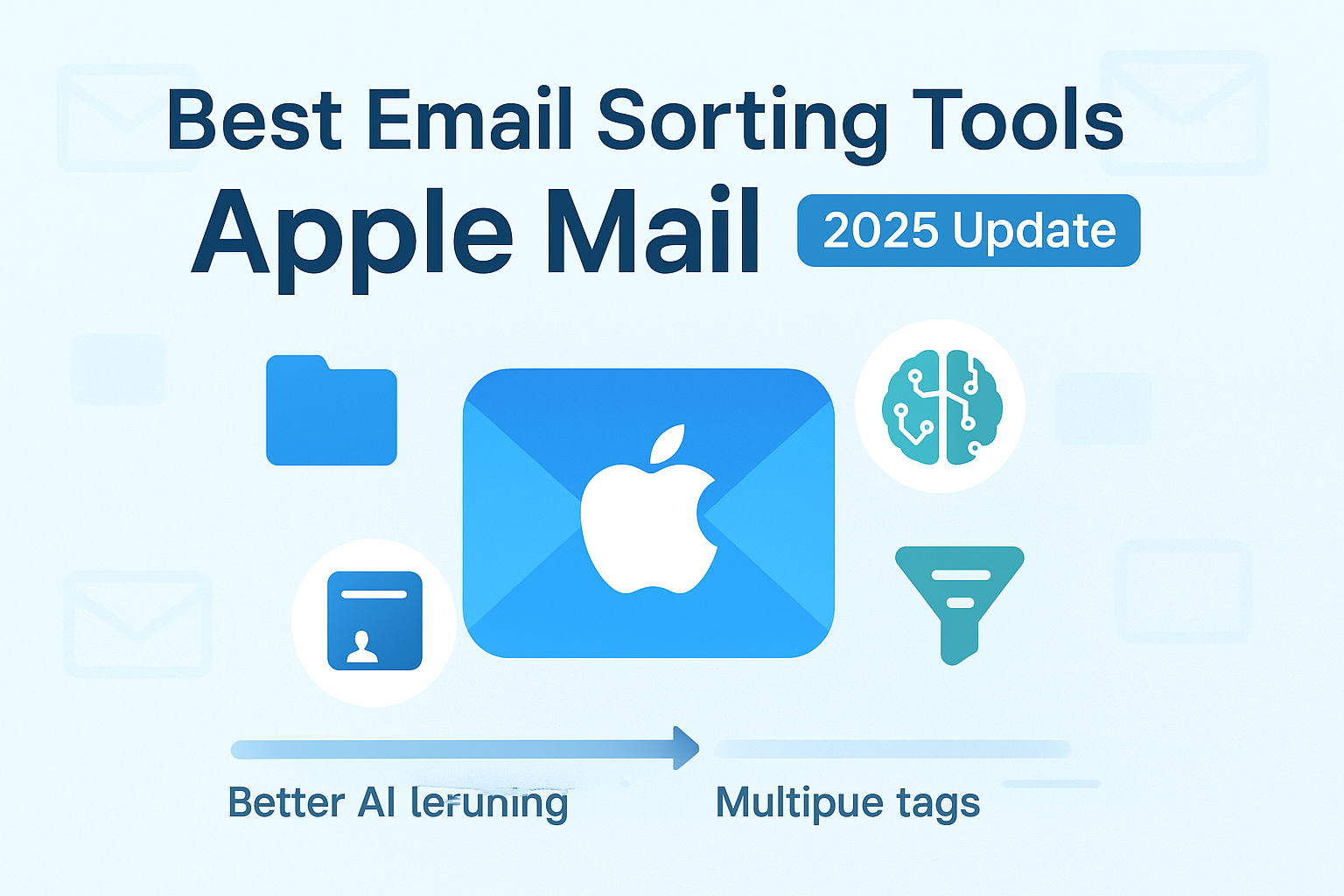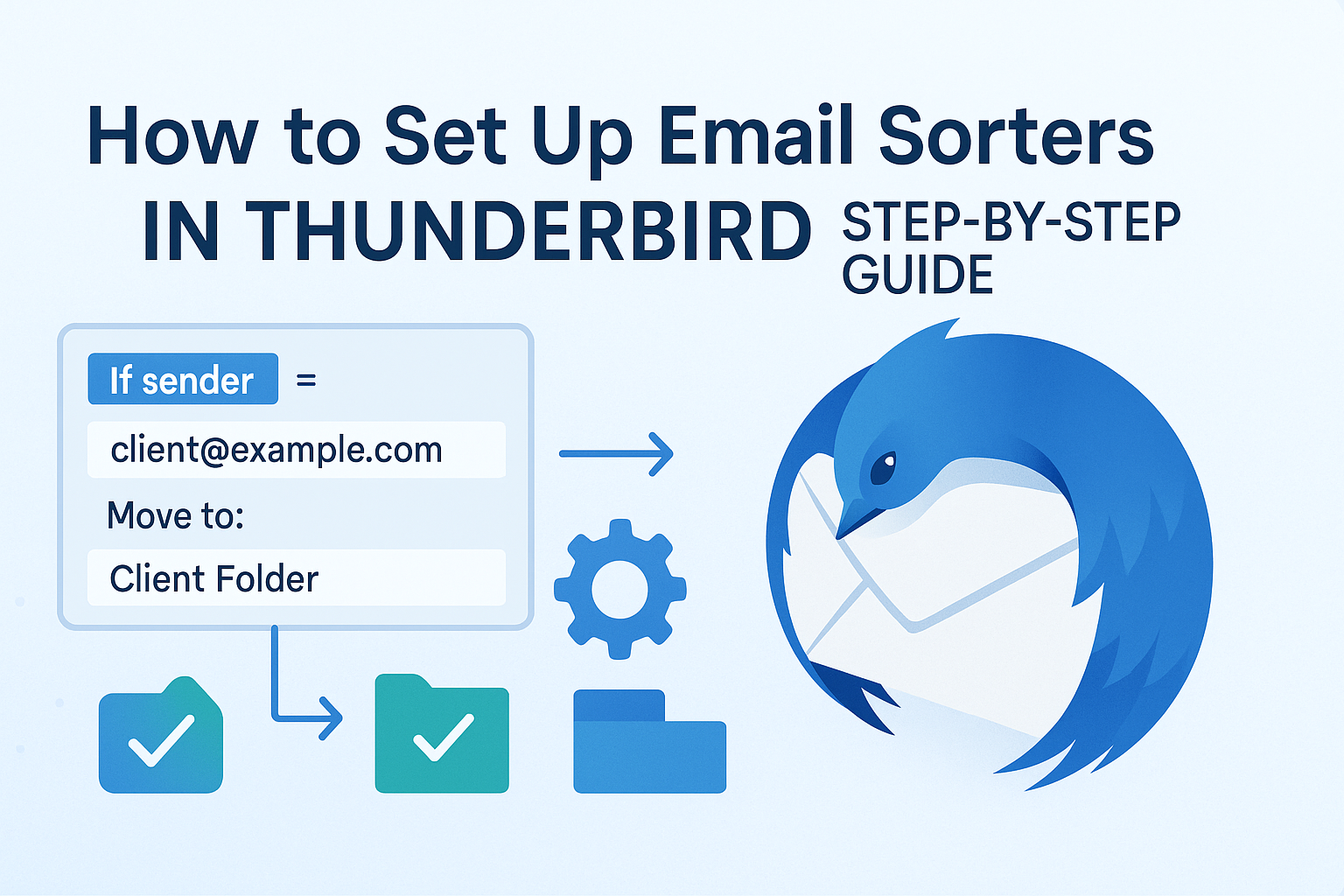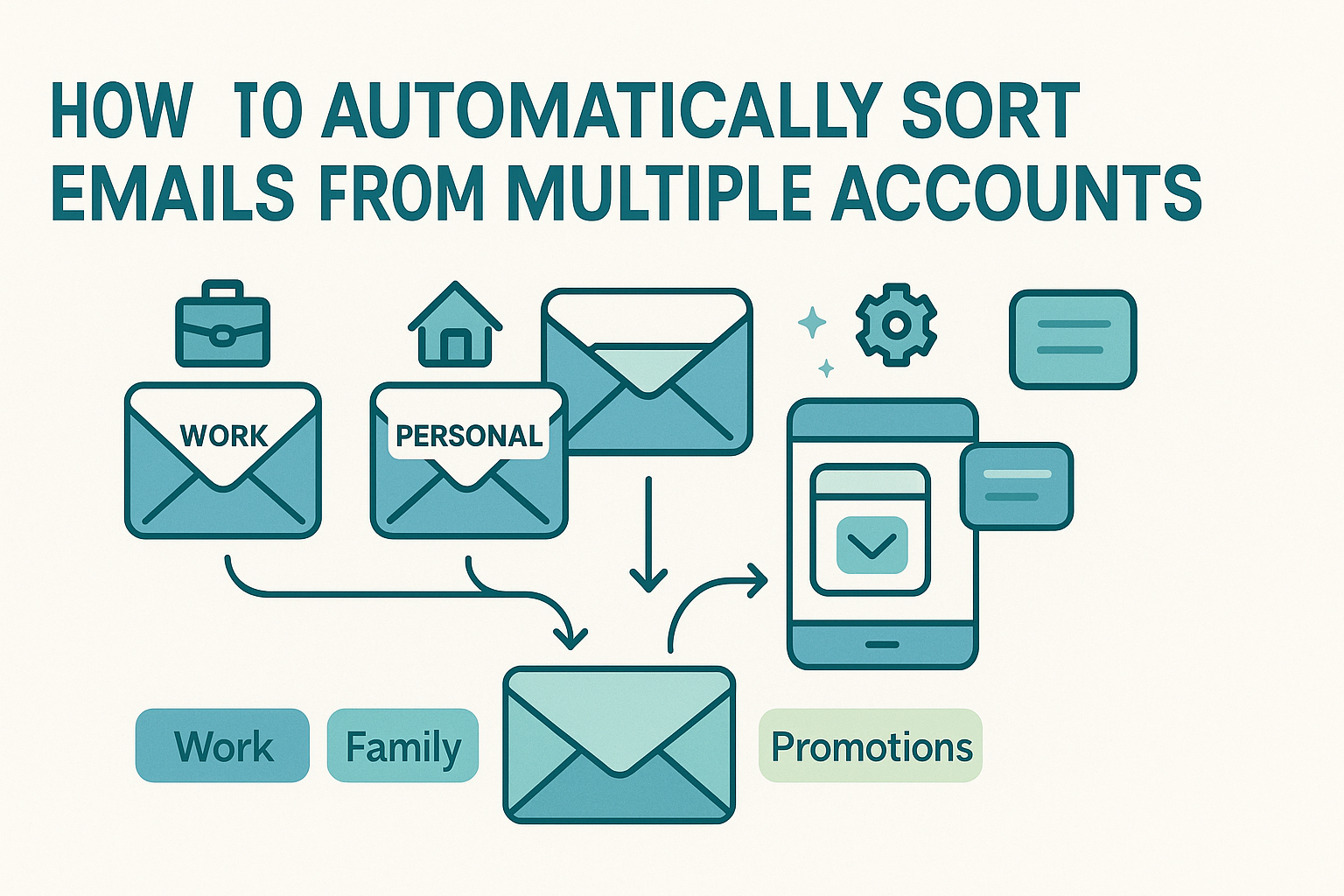Mistakes to Avoid When Using Email Sorters can turn a helpful tool into a source of frustration. Email sorters have changed how we manage our inboxes. They save time and keep important messages organized. But if they are not set up correctly, they can cause more problems than they solve.
Even with smart features like AI sorting and real-time filters, common mistakes like wrong rules or ignoring updates can send emails to the wrong folders or leave your inbox messy. Email sorters are not “set it and forget it” tools. They need regular attention and adjustments to work well.
In this post, we will share the top 7 mistakes people make when using email sorters. We will also show you how to fix these problems. Whether you are new or want to improve your system, these tips will help you take control and make your inbox easier to manage.
Mistake 1: Not Automating with Smart Rules
Many people start using email sorters but stop at the basics. They manually drag emails into folders or apply labels themselves, thinking that’s the whole point of organizing. But what they’re missing is the power of automation.
When you don’t take full advantage of smart rules, you’re not just wasting time—you’re creating inconsistency. You might remember to label invoices this week but forget next week. Or you might file one client’s message properly but misplace another’s in a rush. Smart rules eliminate this guesswork. They let you define what should happen to specific types of emails, and then apply those instructions automatically—every time.
For example, a smart rule can detect when a message comes from a specific sender, includes certain keywords, or contains an attachment. Based on that, it might apply a label like “Finance,” move the message to a designated folder, mark it as read, or flag it for follow-up. You can even chain these actions together for complex workflows.
The best part? These rules run silently in the background. Once they’re set, your email begins to sort itself, freeing you to focus on the messages that really matter. If you’re new to this or haven’t explored it deeply, we recommend reading How to Create Smart Email Rules Using Email Sorters. It walks you through setting up your first rules and includes tips on common triggers, best practices, and how to avoid rule conflicts.
By skipping smart rules, you’re essentially handling email the hard way. But with just a little upfront setup, your inbox can become a well-oiled, low-maintenance machine.

Mistake 2: Poor Rule Organization
Smart rules are powerful, but they’re only as effective as the structure behind them. One of the most common mistakes people make is setting up rules in a messy, uncoordinated fashion. This usually happens when users build rules one at a time without considering how they interact with each other.
Let’s say you’ve created ten different filters. One moves emails from your boss to the “Management” folder. Another flags messages with the word “urgent.” A third labels anything with attachments as “Documents.” What happens when you get a message from your boss marked “urgent” with an attachment? Which rule wins? Without a clear hierarchy or structure, the results can be unpredictable—or worse, the message gets lost in the shuffle.
This is where nested rules come in. By organizing rules in layers, you can apply logic in a structured, conflict-free way. Think of it like a decision tree: first, the system checks if the email is from your boss. If yes, it applies the “Management” label. Then it checks if it’s urgent and flags it. Finally, it checks for attachments and adds a second label. Each rule executes in a logical sequence rather than all at once.
Properly structured rules not only reduce errors—they make troubleshooting easier. When something goes wrong, you can trace it back through your layered system instead of digging through a pile of overlapping commands. Plus, it makes scaling easier. As your workflow grows, you’ll have a clear framework to plug new rules into without causing chaos.
To master this kind of setup, check out How to Create Nested Rules in Advanced Email Sorters. It provides visual examples, real-world templates, and troubleshooting tips to help you organize even the most complex workflows with confidence.
Avoiding poor rule organization doesn’t just make your inbox cleaner, it makes your whole sorting system smarter, faster, and more predictable.
Mistake 3: Not Training AI Sorters Correctly
With AI now embedded in many popular email platforms, email sorters have become far more advanced. But one of the most overlooked mistakes is assuming that AI will automatically know how you want your inbox organized. AI sorters are powerful, but they aren’t mind readers. They rely heavily on training data, which in email terms means your tagging, corrections, and categorization habits.

When users fail to consistently tag emails or manually adjust misfiled messages, AI lacks the feedback it needs to improve. Over time, this leads to poor results: important messages being sent to the wrong folder, low-priority emails marked as urgent, or promotional content landing in your main view.
Training AI is not a one-time task. It’s a gradual, ongoing process. You need to engage with the sorter. approve suggestions, reject mislabels, and apply consistent tags. This gives the system the cues it needs to learn what matters to you. And that’s the whole point: personalized sorting based on real behavior, not default settings.
If your AI-powered sorter is underperforming or causing more chaos than clarity, take a step back and assess how you’re training it. Start using manual labels and corrections more deliberately, and review the suggestions it makes. This teaches the model what “important,” “junk,” or “follow-up” really means to you.
To improve your training strategy, refer to How to Train AI Email Sorters with Custom Labels. This tutorial explains how AI learns from your tagging behaviors and provides actionable tips for refining its performance through simple, daily inbox actions.
Skipping this training process might leave you with an expensive tool that doesn’t actually help, so treat your AI sorter like an assistant who needs onboarding, not just access.
Mistake 4: Ignoring Privacy in Cloud-Based Sorters
Cloud-based email sorters are a lifesaver for busy professionals. They offer 24/7 access, instant syncing across devices, and advanced AI tools. But there’s a hidden danger that many users overlook: privacy and data security.
If you’re using a cloud-based platform without understanding its security settings, you could be exposing sensitive information—customer data, internal memos, or financial documents, to risks like unauthorized access, leaks, or even compliance violations. This is especially risky if you’re handling confidential material or working in regulated industries.

Common mistakes include using weak passwords, skipping two-factor authentication, not reviewing app permissions, and assuming that “big name” providers are automatically secure. But even top-tier platforms need to be properly configured to protect your data.
You should also pay attention to how your sorting rules interact with data privacy. For example, auto-forwarding emails with attachments to external accounts might breach confidentiality if not encrypted or logged correctly. AI features that scan message content should also be reviewed for how they handle sensitive terms or proprietary information.
Taking a few simple steps, like encrypting messages, regularly updating your access controls, and auditing third-party integrations, can significantly reduce these risks. Think of it as locking the doors to your digital office.
If you’re using or considering cloud-based tools, the article How to Secure Your Data When Using Cloud-Based Email Sorters offers clear, practical strategies to keep your sorting system safe without sacrificing performance.
Neglecting security doesn’t just put your inbox at risk, it can compromise your entire workflow and reputation. So treat privacy settings as part of your sorting strategy, not an afterthought.
Mistake 5: Skipping Regular Rule Updates
Here’s something most people don’t realize: your email sorting rules aren’t “set and forget.” Over time, even the best-built rules become outdated. New senders emerge, clients change domains, keywords evolve, and your priorities shift. If you don’t review and update your rules regularly, your system slowly becomes irrelevant, or worse, it starts misfiring.
For instance, maybe you created a rule a year ago that labels all messages with “Invoice” in the subject line. But now your accounting software has changed, and those messages come with a different subject tag. Suddenly, those important messages are slipping through the cracks. Or perhaps you’ve added new team members and haven’t included their emails in key filters.
This is especially true in fast-moving work environments. Projects evolve, departments grow, and your workflow needs to adapt. When rules aren’t updated, your inbox starts to feel cluttered again, even though all the tools are still running.
A good habit is to schedule a monthly or quarterly rule audit. Review your most-used filters, test them against recent emails, and update conditions as needed. Pay close attention to rules that no longer trigger, or those that have too many false positives. And if you’re using smart rules or AI, monitor their logs and results to see how well they’re still performing.
Think of this like cleaning out a filing cabinet. You wouldn’t keep using a folder labeled “Q1 2022” forever, so don’t let your inbox do it either. Refreshing your rules keeps your sorting system lean, relevant, and effective.
Mistake 6: Overcomplicating Sorting Systems
When it comes to email organization, more isn’t always better. One of the most common traps users fall into is overbuilding their sorting systems, creating dozens of folders, stacking too many labels, and applying overly complex rules. The result? An inbox that’s as confusing as it was before you started organizing.
Imagine a setup where you have separate folders for each client, each type of document, each priority level, and every email gets filtered into five places. At first, this might feel efficient. But when you need to find something, or when an email doesn’t quite match any one rule, chaos returns. You spend more time decoding your own structure than reading actual messages.
Overcomplication also leads to rule conflict. When too many filters are active at once, especially without clear prioritization, messages may end up in unexpected places, or not show up at all. Worse, it becomes hard to onboard team members or troubleshoot problems when even you don’t fully remember how your system works.
Instead of trying to account for every scenario, aim for clarity and function. Focus on what truly matters to your work: key clients, urgent messages, financial records, or action-required items. Build around those categories first. Use broader labels or folders and rely on search or AI assistance to handle the fine-grain filtering.
When in doubt, start small. A minimal system that works 90% of the time is better than a complex one that breaks under pressure. If you’re tempted to create yet another sub-folder, ask yourself: will this make retrieval faster, or just look organized?

In short, design for ease of use, not theoretical perfection. Your future self (and your team) will thank you for it.
Mistake 7: Not Tracking Sorting Activity
Once your sorting system is live, how do you know it’s working? How can you catch when rules misfire or when important emails vanish without a trace? The answer is audit logs, and skipping them is a major oversight.
Many platforms, especially those with smart or enterprise-level sorters, provide access to rule execution logs. These show what rules were triggered, which actions were taken, and how messages were handled. But many users never check them, assuming “no news is good news.” That’s a mistake.
Without tracking activity, you won’t know if a client’s email was filtered incorrectly or if a smart rule stopped functioning after a platform update. This can lead to missed deadlines, poor communication, or compliance risks. It also makes it hard to spot patterns—like rules that never trigger or rules that apply too broadly.
Regular log reviews let you catch and correct issues early. Did your “High Priority” label apply to the right emails last week? Were any finance emails misfiled under “Admin”? The logs tell the story. This data also helps you refine your sorting strategy, improving accuracy and efficiency over time.
If your platform supports audit tools, use them weekly or at least monthly. Set alerts for errors if available, and document any recurring issues so they can be fixed systematically.
Failing to review sorting activity is like driving without a dashboard. you’ll only know something’s wrong when it’s already too late.
Conclusion
Email sorters are supposed to make life easier, but only when used the right way. As we’ve seen, even small missteps can create frustration, misfiled messages, or security risks. The good news? Every one of these mistakes has a fix.
Start by embracing automation with smart rules to remove manual sorting. Then, organize your filters using nested rules to avoid rule conflicts.
The more intentional you are, the more value you’ll get from your email sorter. It’s not about doing more, it’s about building smarter habits that keep your inbox working for you, not against you.
Frequently Asked Questions
What are the most common beginner mistakes in using email sorters?
Skipping automation, overcomplicating folder structures, and ignoring rule updates top the list. This guide walks through each and how to fix them.
How do I know if my rules are too simple or too complex?
If you still spend a lot of time sorting manually, they’re likely too simple. If messages end up in unexpected places, they’re likely too complex. Aim for clarity and reliability.
Is it safe to use cloud-based AI sorters for confidential work?
Yes, but only with proper settings. Use strong passwords, enable encryption, and refer to [cloud-based sorter security] to protect sensitive information.
How often should I update my email rules?
Every few months is ideal, or whenever your workflow changes significantly. Outdated rules can lead to missed emails and clutter.
Can I recover emails misrouted by incorrect filters?
Usually, yes. Check logs and sorting history to trace where the message went. Most platforms allow manual override and recovery from archive or spam folders.




